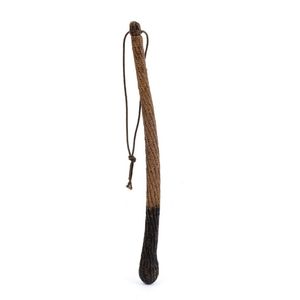19th Century Midshipman's Weighted Cosh
A midshipman's cosh, woven string, possibly baleen and lead weighted end, 19th century, 42 cm long
You must be a subscriber, and be logged in to view price and dealer details.
Subscribe Now to view actual auction price for this item
When you subscribe, you have the option of setting the currency in which to display prices to $Au, $US, $NZ or Stg.
This item has been sold, and the description, image and price are for reference purposes only.
- Baleen - Baleen is the filter feeder system in a baleen whale, and these whales have several hundred plates of baleen with a hairy fringe on their upper jaw.
Baleen refers to the solid plate, and it is historically important as it was sought by whalers as a by-product of the whaling industry, who called it whalebone, though it is not made of bone at all, and used it for scrimshaw.
The earliest artefacts were made of baleen produced from Arctic whaling in the 17th century.
In the 19th century baleen was an important raw material, comparable to present-day plastics. Its thermoplastic nature and strength meant it could be used to make a wide variety of functional and decorative objects.
Sailors used baleen to make sewing boxes and other small containers and another common use was brush bristles; it was even used as runners on toboggans.
Baleen basketry was developed into a craft, with examples of simple baskets to complex woven ones, which could take months to complete.
Other shore-based uses included in corsets, buggy whips, umbrella ribs, canes, skirt hoops and especially as a cheaper substitute for ivory in carving.
This item has been included into following indexes:
